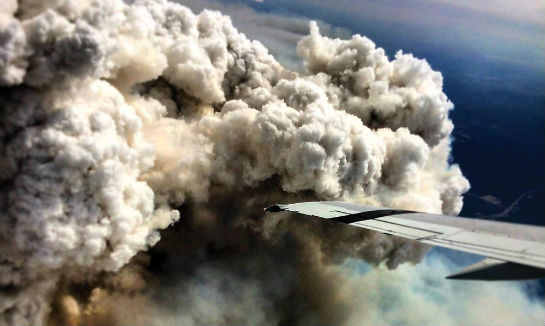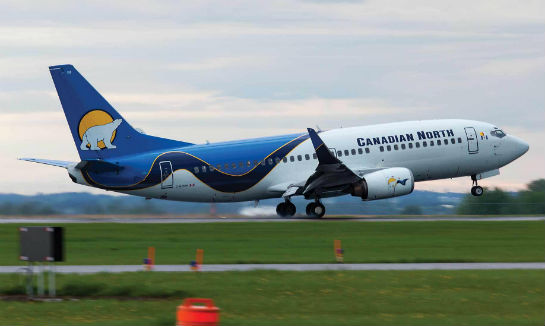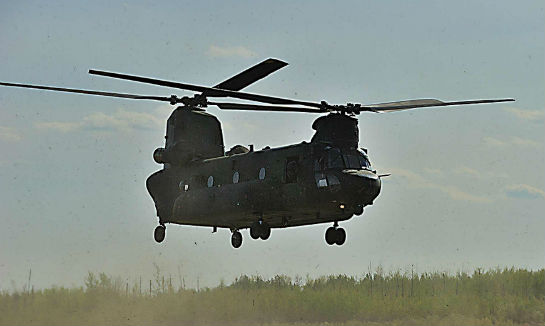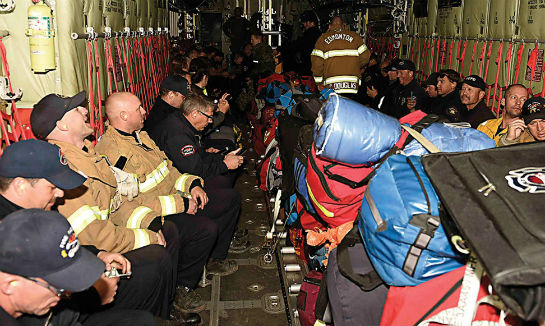An aerial view of the wildfires from a CH-146 Griffon helicopter on May 4, 2016. MCpl VanPutten Photo
As he flew over the fires that engulfed Fort McMurray in a 50-seat Bombardier Dash 8-300, one of the most devastating events in recent Canadian history hit home for Capt Terry Hall.
He was piloting the aircraft for Jazz Aviation LP, heading toward the Shell Albian Sands airstrip north of the city for an evacuation flight that would move passengers to a charter base in Edmonton.
“We went right over it on our way into Albian,” said Hall, 60, a Jazz pilot for the last 27 years. “It was incredible. It was surreal. The smoke was just billowing right over the city.
“We could see where the airport was and you could see the flames right around the airport area, just billowing off the tops of the trees … it really hit home when you actually saw it for real. Devastating.”
Hall’s passengers at Albian were from all walks of life, he said—from young kids to the elderly, people in wheelchairs and businessmen. He was amazed at how calm they were.
“They were all grateful,” he said. “They got on the aircraft and [were] very quiet.”
As devastating as it was, the Fort McMurray disaster seemed to bring out the best in Canada’s aviation community.
Big companies and smaller ones put competition aside and banded together to help Albertans in a time of need.
Major airlines added seats and shifted their schedules to divert larger planes to Fort Mac. Smaller charter operations did yeomen’s work on short notice, flying thousands of people to safety in a dynamic situation that seemed to change by the hour.
A smoke plume as seen from a Canadian North aircraft. Killian Jackson Photo
Along with people, pilots ferried family pets and basic necessities like food, water and diapers.
“It really doesn’t surprise me,” said Hall. “I think it’s just Canadians in general. That’s what we do. When there are tragedies we drop everything and put all our resources together and go in and do what we can.”
Big names, big-time help
Canada’s airlines played a major role in the evacuation. Jazz Charters and Air Canada operated 23 evacuation flights out of Albian Sands and Suncor Energy’s Firebag work camp to Edmonton and Calgary.
Jazz used Dash 8-400, Dash 8-300 and CRJ 200 aircraft for the evacuation charters, and Air Canada added more than 5,000 seats for Alberta via additional flights and by sending larger aircraft to meet demand.
Air Canada also waived baggage fees, pet fees and hunting, equipment and bike handling fees for all passengers travelling as a result of the fires.
“We transport people in our business, and because of the nature of aviation we’re able to deploy our resources, including our worldwide fleet, to help others during critical times of need,” said Air Canada spokesperson Angela Mah in a statement.
WestJet evacuated passengers and employees from Fort McMurray International Airport after it closed on May 4, but also flew about 100 flight segments in and out of Albian Sands and Firebag, said company spokesperson Lauren Stewart.
“Overall, we estimate we evacuated around 6,000 people out of the area, and this was into both Calgary and Edmonton,” continued Stewart.
North Cariboo Air used an Avro RJ100, Dash 8 300s and Beechcraft 1900s to transport thousands of people during the evacuation. The company also transported firefighters from Calgary and Manitoba (pictured here). North Cariboo Air Photo
WestJet used Boeing 737-700 and 737-800 airliners during the evacuation flights, carrying between 130 and 168 guests at a time.
“Most of the aircraft were going up empty and then coming back full of people,” said Stewart.
WestJet also allowed pets on its flights, waiving a requirement to keep them in proper kennels. It was a measure other airlines also took, including Canadian North and Enerjet, attracting attention on social media.
“When people were evacuating Fort McMurray they grabbed everything that they loved,” said Stewart. “They took their kids and they took their pets, and I think a lot of people didn’t really know what the next step was going to be.
“They weren’t leaving home with kennels. A lot of them weren’t leaving home with, even, any other clothing other than what they had on their back.
“So it was important for us to keep families together and to get everybody to safety; and pets, to many people, are part of the family.”
From north to south
Canadian North operated 312 flights in Alberta during the early stages of the fire, filling 16,882 seats as they moved evacuees and oil sands workers to and from work camps north of Fort McMurray from May 3 to 9.
The airline used eight Boeing 737-300s and one Boeing 737-200 for the work, concentrated mainly on the Fort McKay/Horizon Airport and the Albian Sands aerodrome.
Members from 417 Combat Support Squadron survey the damage created by the wildfires in the Fort McMurray area on May 4. MCpl VanPutten Photo
“We were watching, in our operations centre, news reports of the fire and constantly watching what was happening,” said communications manager Kelly Lewis. “And we were on the phone constantly with our oil sands clients as well.
“So it was just a rolling ball of change that we had to stay on top of. The big thing, though, is that we provide crucial air services for our scheduled northern routes, and just foregoing that during this crisis was not an option. It’s a critical service that we provide for the north.
“So we had to be very strategic in how we allocated our fleet and our crew resources.”
Air North completed contract flights with a Boeing 737-500 from Firebag to Edmonton during the evacuation.
“Aviation in Canada’s north is relatively unique and airlines constantly work together to find solutions that would not be needed in the south, so as a result we are used to working together and helping each other out,” said Allan Moore, chief operating officer of Air North.
“There were no surprises as the northern airline community is tightly knit and works well together, especially in times of need. The response to this disaster was really an affirmation of how close the community is and how well we work together every day as opposed to in times of disaster.”
Small operations, huge impact
Enerjet used two Boeing 737-700s to move about 5,600 people on more than 60 flights during the disaster.
Flair Airlines operated at least 72 flights during the evacuation. Its subsidiary, North Sands Air Services, played a key role in coordinating lift from seven different carriers. Rob Sowald Photo
“I think one of the greatest challenges was the congestion at the aerodromes,” said Darcy Morgan, chief commercial officer of Enerjet. “The facilities at the aerodromes are meant to handle a relatively small number of aircraft at any one time, and a relatively small number of people to be processed.
“Even though there are thousands and tens of thousands of workers in Fort McMurray moving though these camps and a fly-in, fly-out program, the staging at the aerodrome is very controlled.”
While the Fort McMurray evacuations were a challenge because the flights weren’t scheduled, they were otherwise much like a normal operation, according to Morgan.
“I think it’s very much a mixed emotion for us,” he said. “We felt grateful that we could help others in need.
“And yet, we knew at the same time that we would have all been much happier if this had not happened at all.”
Flair Airlines operated at least 72 flights during the evacuation, using its own Boeing 737-400s, as well as an Embraer 175 and a Dornier 328 owned by an oil company, according to Flair vice-president of business development Chris Lapointe.
North Sands Workforce Logistics, a subsidiary of Flair, also worked with a number of airlines to get people out of Fort McMurray.
WestJet evacuated an estimated 6,000 people using Boeing 737-700 and 787-800 airliners. Galen Burrows Photo
North Sands played a key role in coordinating lift from seven different carriers, with its team working around the clock to provide oversight and coordination services over a week-long period, said Lapointe.
“Right from the very beginning, our business has been set up to basically be quite nimble,” he said. “We’ve geared ourselves to being able to respond on short notice.”
He acknowledged the evacuation was a group effort in which many companies pulled together.
“We were calling our competitors for lift and competitors were calling us for lift, and we were all working together to try to just do what we could do to get as many people moving as possible,” he said.
North Cariboo Air used an Avro RJ100 as well as Dash 8-300 and Beech 1900 aircraft to fly thousands of people during the evacuations, said John Green, the company’s vice-president of operations.
“Generally, I don’t think I’ve ever seen a situation turn so quickly,” he said. “And it was logistically challenging, just because of the moving target. Now you had a lot of traffic in and out of the oil sands that you didn’t have before … and that all had to be coordinated.”
Summit Air, a charter operation with fixed-wing bases in Edmonton and Yellowknife, N.W.T., transported members of the Athabasca Chipewyan First Nation from Albian to their home community in Northern Alberta.
Summit also evacuated about 60 people from Firebag to Edmonton and then moved some of those passengers on to Calgary using an ATR 72 aircraft. The company completed an additional support flight, bringing people and supplies from Edmonton to the Fort Chipewyan First Nation.
Canadian North operated 312 flights in Alberta during the early stages of the fire, moving evacuees and oil sands workers to and from work camps north of Fort McMurray. Jason Pineau Photo
“We’re proud to have been a part, even though it was a small part,” said Matthew McElligott, vice-president, business development with the Summit Aviation Group.
“It was a horrible situation and given our growing footprint in Alberta, we just wanted to help out in any way possible.”
Calgary-based Skyplan also performed dispatch services for Enerjet, Air North and R1 during the evacuations.
“Obviously, the workload was pretty intense there for awhile,” said Craig Mariacci, vice-president of sales for Skyplan.
“People worked extra-hard and overtime to make sure everything was done properly, and I think our dispatch team did an incredible job in handling this because it was pretty hectic.”
Military help
On May 4, with 1,600 structures said to have been destroyed and 10,000 people gathered at oil camps, the province declared a state of emergency. It requested help from the Canadian Armed Forces, which deployed 65 aircrew, liaison officers, and other support staff to the region.
Four CH-146 Griffon helicopters and one CH-147F Chinook, as well as one CC-130J Hercules fixed-wing aircraft, were mobilized as part of Operation Lentus, a military contingency plan that outlines a response to provincial and territorial authorities in the event of a major natural disaster.
Fort McMurray represented the first domestic humanitarian mission for the RCAF’s CH-147F Chinook helicopter. It delivered 8,200 pounds of food, water and other supplies to Fort McKay First Nation on May 8. MCpl VanPutten Photo
During the operation, Joint Task Force West shipped 124,700 pounds of freight, moved a total of 367 evacuees to safety, and transported 173 firefighters in and out of the affected area.
Photos showed military aircraft surveying the damage near thick clouds of milky-white smoke, while personnel spoke with displaced residents. Others showed soldiers organizing pallets of relief supplies and working with local authorities to unload food and other materials from the belly of the Herc.
“It was moving critical equipment, some of it was moving first responders,” said Capt Thomas Edelson of the Canadian Joint Operations Centre in Ottawa, where the operation was headquartered.
He wasn’t on the ground in Fort McMurray, but learned second-hand that flying conditions were a challenge.
“When a place is that smoke-filled, there’s obviously a visibility issue,” he said.
Oil companies open doors
While flames blazed a horrible path, razing buildings and licking the murky sky, thousands of evacuees fled to safety at work camps north of the city, in Alberta’s oil sands. Oil companies threw open their doors to people displaced by the fires, housing them and serving as transportation hubs for flights to other Alberta cities.
“I think the oil sands companies, they deserve limitless praise for what they did,” said Air North’s Kelly Lewis.
“They opened up their sites to evacuees immediately, without any hesitation, and fed and clothed and housed them for days, for thousands of people.”
A CC-130J Hercules from 436 Transport Squadron, 8 Wing Trenton, Ont., transports firefighters to relieve those already on location on May 9. Cpl Manuela Berger Photo
Oil companies spared no expense and stopped at nothing to help displaced citizens that showed up at their doors, said Enerjet’s Darcy Morgan.
“These are private companies with private aerodromes and private camps,” he said.
“And when thousands of citizens showed up at their gate, these oil companies did everything they possibly could to provide safety, security and comfort to the displaced citizens.
“They went far beyond what would have been, I suppose, required of them, to do. And I think they should be applauded for that.”
Another view from the sky
As day turned to dusk, Lanny Benoit could see the glow of red through the clouds and smoke. It was an intense, hot fire, unlike any he’d seen before.
“Just seeing the intensity, it was breathtaking,” he said.
Benoit saw the fires of Fort McMurray from the cockpit of a Bombardier CRJ200 he piloted for Calgary-based R1 Airlines, where he also serves as vice-president of operations.
R1 supported the Alberta government with medevac standby during the disaster and also moved people out of oil sands camps north of the city.
He could not say enough about how people got together during the tragedy. There were baby supplies and food for evacuees, food even for dogs and cats.
Airport personnel were helping with animals, making sure they were fed. Kids were playing and others were talking, “just letting these people have an ear.
“It made me re-evaluate and to see what’s important in life,” he said. “It was pretty touching.”
As far as competition, he acknowledged all companies are trying to be successful.
“These times, that stuff’s just put down and it’s, ‘How can we work together and what can we do?’”
Ben Forrest is assistant editor of Skies magazine. Before joining Skies in 2015, he spent the better part of 10 years in the newspaper industry, where he worked as an editor, sports editor and general assignment reporter. Ben is a graduate of Western University’s Master of Arts in Journalism program.

















